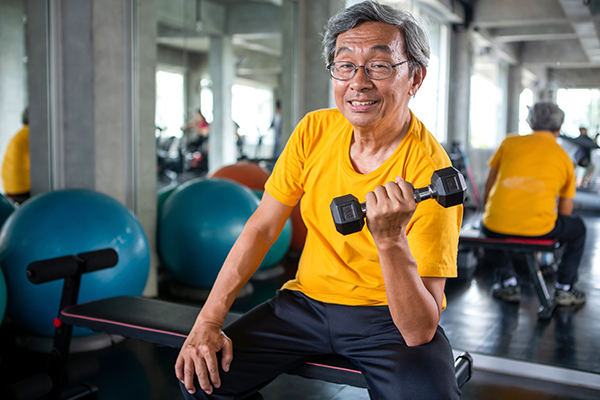Exercise
Exercise is an important part of overall wellness for patients with bronchiectasis and nontuberculous mycobacterial (NTM) lung disease.1 It is known to help with anxiety and depression, which can be common in people with bronchiectasis.2 Exercise has also been linked to better health-related quality of life.3 When you exercise you take in larger breaths. These larger breaths may be helpful with clearing mucus and preventing tiny air sacs in the lungs from collapsing. Exercise training cannot reverse lung disease, but it may assist with improving shortness of breath. It can also help reduce how often flare-ups (or worsening of your disease) occur. These flare-ups are called exacerbations (x zaa cer bay shuns).3

Before you begin exercising:
- Talk to your doctor first about your plans to exercise. Ask questions like “how often should I exercise? Are there any exercises that I should avoid?”
- Start slow. If exercising is not something that is part of your normal routine, you will want to start off slow. Your body needs to become used to the activity.
- Wear oxygen if it is prescribed. Muscles in the body use oxygen to do work. If you have been prescribed oxygen continuously or “with exertion,” wear it while exercising.
- Monitor your heart rate and the amount of oxygen in your blood with a pulse oximeter (ox sim ee ture). Pulse oximeters are small devices that can measure the amount of oxygen in your blood. The device is attached to your finger. These devices can also measure your heart rate. This does not hurt and is easy to do. Your oxygen level should stay at 90% or greater during your exercise routine.4
- Have a phone nearby so you can call someone in the event of an emergency.
- Hydrate. Drink water throughout exercise to prevent dehydration (dee high dray shun). Water can also help to thin the mucus in your airways.
- Wear sturdy footwear like tennis shoes. Avoid exercising in sandals, slippers, or bare feet.
- Keep your rescue inhaler (if prescribed) nearby. Talk to your doctor about whether you should be using it before exercising. – It may help to open your airways and reduce how long it takes you to recover from feeling out of breath.
Reasons to avoid or stop exercising:
- Feeling dizzy or shaky
- Nausea
- Diarrhea
- Chest pain
- Out of portable oxygen
- Oxygen concentrator is not working well.
- Low oxygen saturation (per the pulse oximeter)
- Fever
What is a good exercise program?
Exercise programs can vary based on your personal needs and abilities. Typically, they consist of a warmup, aerobic exercise (to build endurance), strength training of lower and upper body (to build muscles), and stretching.5
Aerobic exercises can include:
- walking
- dancing
- bike riding
- swimming
- marching in place
- rowing.
Strength training exercises can include:
- use of hand weights,
- use of resistance bands
- calisthenics- strength training using only your body weight (e.g., a pushup)
- isometric exercises- strength training by squeezing a muscle at a specific angle (e.g., a plank)
Your doctor may be able to suggest specific exercises (or guidelines for exercise) that are best for your personal needs and abilities. A good exercise program is not only fun, but safe.

What should you expect during exercise?
- If it has been a while since you last exercised, start off slow. Take breaks when needed and limit your first few exercise sessions to 20-30 minutes.
- Exercising at a moderate intensity (that could also be described as “somewhat difficult”) is a good way to make progress without pushing your body too hard. If you cannot carry on a conversation while exercising, then you may be working too hard.6
- You may feel an increased shortness of breath as you exercise. It is common for individuals with chronic lung diseases to feel mild to moderately short of breath with exercise, but it is important that you monitor this.
- Use breathing techniques to reduce the feeling of being short of breath.6
- If your shortness of breath starts to concern you or feel overwhelming, stop and rest. It is important to listen to your body.
- Taking larger, deeper breaths while exercising may cause you to cough. Pause your exercising to clear your airway of any mucus.
- Log your activity in a journal or notebook to monitor your progress and share your activity with your doctor. Click here to download a simple Exercise Tracking Log that you can print to log your activity.
What should you do when you are finished with your exercise routine?
- Perform some stretches in order to lengthen your muscle groups. This will also promote circulation to prevent muscle soreness.
- Drink plenty of fluids to stay well-hydrated and to flush any toxins from your muscles.
- Decide the difficulty of your exercise. Are your muscles extremely sore? Are you exhausted? If so, consider changing the level of your exercise routine.
- Make a plan for your next workout and set goals for yourself.

Other ideas to consider:
- Exercising with friends can be fun, but it may also be challenging to keep up. Pick an exercise activity in which each person can go at their own rate.
- Choose different exercises to prevent boredom.
- Increase your exercise routine as you build strength and endurance.
- Reward yourself as you reach your goals.
***Always check with your doctor before starting a new exercise routine or activity. Your doctor will let you know how often you should exercise and how long your exercise routine should be. The content on this page is not meant to replace any advice from your doctor. ***
References:
1Chalmers JD, Sethi S. Raising awareness of bronchiectasis in primary care: overview of diagnosis and management strategies in adults. NPJ Prim Care Respir Med. 2017;27(1):18. doi: rel="noopener" target="_blank" https://doi.org/10.1038/s41533-017-0019-9
2Wynne SC, Patel S, Barker RE, et al. Anxiety and depression in bronchiectasis: response to pulmonary rehabilitation and minimal clinically important difference of the Hospital Anxiety and Depression Scale. Chron Respir Dis. 2020;17:1479973120933292. doi: rel="noopener" target="_blank" https://doi.org/10.1177/1479973120933292
3Lee AL, Hill CJ, Cecins N, et al. The short and long term effects of exercise training in non-cystic fibrosis bronchiectasis--a randomized controlled trial. Respir Res. 2014;15(1):44. doi: rel="noopener" target="_blank" https://doi.org/10.1186/1465-9921-15-44
4Gloeckl R, Marinov B, Pitta F. Practical recommendations for exercise training in patients with COPD. Eur Respir Rev. 2013;22(128):178-186. doi: https://doi.org/10.1183/09059180.00000513.
5The COPD Foundation. Exercise for someone with COPD. COPD Foundation website. Updated 2020. Accessed March 9, 2021. https://www.copdfoundation.org/Learn-More/I-am-a-Person-with-COPD/Exercise.aspx
6The Cleveland Clinic. COPD: Exercise and activity guidelines. The Cleveland Clinic website. Published September 2018. Accessed March 9, 2021. https://my.clevelandclinic.org/health/articles/9450-copd-exercise--activity-guidelines.